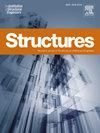一种改进的自适应EMD-SVD方法用于铁路桥梁动应变处理
IF 4.3
2区 工程技术
Q1 ENGINEERING, CIVIL
引用次数: 0
摘要
提出了一种改进的自适应经验模态分解(EMD)方法,用于提取铁路桥梁在移动列车荷载作用下的高精度动态分布应变响应。针对铁路桥梁特殊的频率特性,将奇异值分解(SVD)与EMD相结合,有效分离了铁路桥梁的动态分布应变分量。然后,对小波分解、EMD和改进后的方法进行了对比分析。该研究专门研究了这些信号处理技术对移动列车载荷下动态和准静态应变分离精度的影响,旨在确定动态分布应变测量的最佳方法。该方法在沪昆高铁全尺寸桥梁上进行了实验验证。结果表明,改进后的自适应方法在处理效率和稳定性方面具有优势,其性能不受内禀模态函数(IMFs)个数选择的影响。该方法提高了信号处理的效率和精度,适用于批量处理大规模监测数据。本文章由计算机程序翻译,如有差异,请以英文原文为准。
An improved adaptive EMD-SVD method for railway bridge dynamic LG-strain processing under moving trainloads
This paper proposes an improved adaptive Empirical Mode Decomposition (EMD) method for extracting high-precision dynamic distributed strain responses in railway bridges subjected to moving train loads. Considering the specific frequency characteristics of railway bridges, the improved method integrates Singular Value Decomposition (SVD) with EMD to effectively separate dynamic distributed strain components. Then, case studies comparing wavelet decomposition, EMD, and the proposed improved method are conducted. The study specifically investigates the impact of these signal processing techniques on the accuracy of separating dynamic and quasi-static strains under moving train loads, aiming to identify the optimal method for dynamic distributed strain measurements. The proposed method is experimentally validated on a full-scale bridge of the Shanghai-Kunming high-speed railway. Results demonstrate that the improved adaptive method offers advantages in processing efficiency and stability, and its performance is unaffected by the selection of the number of Intrinsic Mode Functions (IMFs). This enhanced method improves signal processing efficiency and accuracy, thus enabling its suitability for batch processing large-scale monitoring data.
求助全文
通过发布文献求助,成功后即可免费获取论文全文。
去求助
来源期刊

Structures
Engineering-Architecture
CiteScore
5.70
自引率
17.10%
发文量
1187
期刊介绍:
Structures aims to publish internationally-leading research across the full breadth of structural engineering. Papers for Structures are particularly welcome in which high-quality research will benefit from wide readership of academics and practitioners such that not only high citation rates but also tangible industrial-related pathways to impact are achieved.
 求助内容:
求助内容: 应助结果提醒方式:
应助结果提醒方式:


